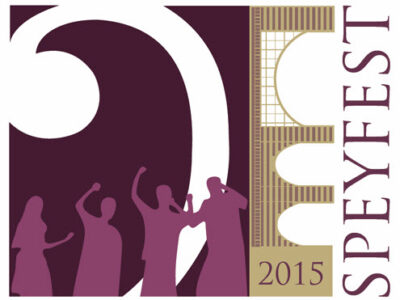Ashleigh MacGregor, who is from Moray and a law student in Edinburgh, recently spent a week on placement with us at Grigor & Young, as part of her course. Alongside this, she is an active member of the Speyfest committee. 2015 is a landmark year for Speyfest and we asked Ashleigh to write something about the festival for our Blog (thanks, Ashleigh, for finding a “legal” angle, as well):
What is Speyfest?
Speyfest is a small village folk festival situated in Fochabers, Moray.
Now in its 20th year, it runs annually in July/August for three days, consisting of concerts, ceilidhs and stomps, featuring some of the world’s best known contemporary and traditional Scottish/Celtic musicians. The festival was first established in 1996 by the well-known fiddler, James Alexander. Over the years, as the festival was continuously growing, it became apparent that there needed to be some changes within its constitution and Ashleigh was part of a small team who carried this out.
Charitable status and legal structure
Speyfest was set up as a registered charity (SC026956), which meant that the legal status of the festival at that time was an unincorporated association.
This came with some disadvantages, including:
- The festival does not have a separate legal personality, so ownership of assets lies with individuals acting on its behalf; in this case, it would be the office bearers/executives of the committee.
- Leases and formal contracts have to be entered into in the names of office bearers. This can cause technical difficulties where there are changes in the people holding these offices.
- Legal proceedings cannot be taken by the organisation but only by individuals representing it.
- The festival may be seen as less professional in the eyes of potential funders due its informal structure.
- (most importantly) This type of association meant that members could be personally liable for debts if the organisation were unable to meet its debts and liabilities out of its own resources.
This was clearly not the ideal situation to be in and therefore changes had to be made. Peter Brash from Grigor & Young in Elgin came along to one of our monthly meetings and gave a very informative presentation covering the advantages and disadvantages of our existing constitution. He highlighted various options available to us and comparisons to similar organisations.
From unincorporated association to SCIO
Overall, it was discussed and agreed that we were to progress with a 2-tier SCIO.
A “Scottish Charitable Incorporated Organisation” is a legal structure which has been purposely built for the charity sector in Scotland. It provides limited liability and a separate legal identity to organisations that would still like to be charities but do not want or need the complex structure of company law. This meant that Speyfest could still retain charity status but reduce the overall risk to our members. It was essentially the best solution.
After Peter’s presentation a few members of the committee got together and filled out the application.
For a law student, it was interesting and enjoyable working alongside Peter and other committee members to ensure that Speyfest could be run to the best of its ability. It was particularly interesting to further my knowledge of contractual obligations and understand how the new constitution should be structured to ensure that it was in the best interests of the festival and its members.
Useful resources
If you are involved in the running of a voluntary association, especially if you have (or would like to have) charitable status, the following website links may be useful:
Office of the Scottish Charity Regulator
The Scottish Council for Voluntary Organisations (Advice on setting up a charity and on legal structures / constitutions)
Join in the fun at Speyfest
There are lots of ways to get involved, as Speyfest celebrates 20 successful years, with the 2015 festival (31 July – 02 August). You can find out more details about the programme, and purchase tickets, via the Speyfest website.


